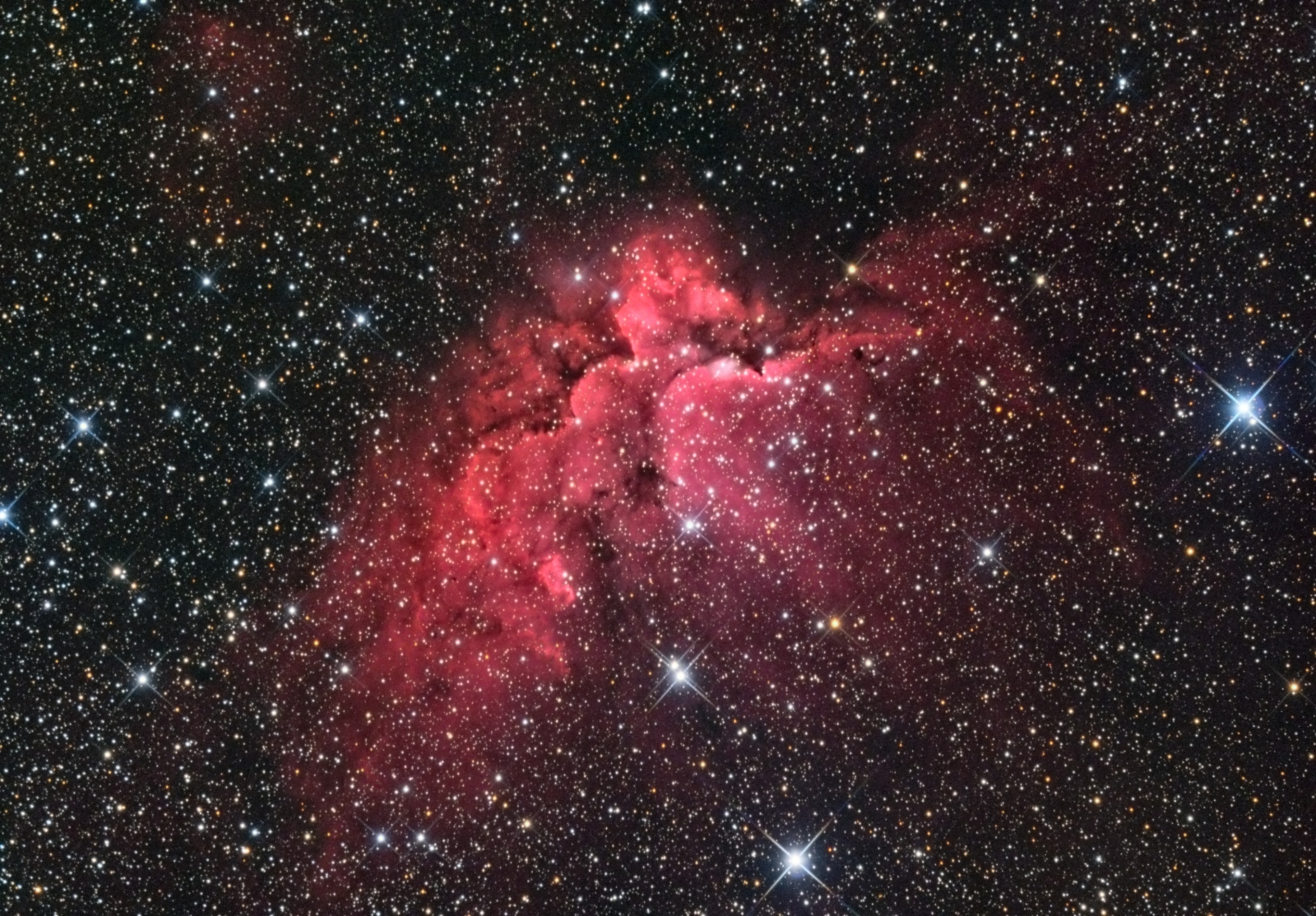The Wizard Nebula and NGC7380
Click image for full size version
January 26, 2015
Sh2-142, known as the “Wizard Nebula,” is a pretty, nebulous object in the constellation Cepheus, the King of Ethiopia. Personally, I couldn’t see a wizard no matter which way I rotated the picture, but maybe someone can set me straight! The red of the object is mostly from glowing hydrogen gas. Just right of centre in the image is the star cluster NGC7380, but I find it hard to see against the rich background of the Milky Way. Both objects are a little more than 7000 light years away, relatively close in cosmic terms! By the way “Sh2” refers to a catalogue of nebulae compiled by an astronomer with the surname “Sharpless.”
Tekkies:
SBIG STL-11000M camera, Baader LRGB filters, 10″ f/6.8 ASA astrograph, MI-250 mount. Guided with STL-11000’s external guider and a 500mm f.l. Lumicon guide scope. Focus with FocusMax. Acquistion, guiding and calibrationwith Maxim-DL. All registration, integration and processing with PixInisight. Shot from my SkyShed in Guelph, Ontario. No moon, excellent transparency, average seeing, no clouds.
5 and 10m subs for RGB totalling 70m R, 70m G and 70m B, and 10x15m Ha (total 6 hr).
Synthetic Luminance:
Creation and cleanup: The R,G,B and Ha masters were combined using the ImageIntegration tool (average, additive with scaling, noise evaluation, iterative K-sigma / biweight midvariance, no pixel rejection). DBE was applied to neutralize the background.
Deconvolution: A star mask was made to use as a local deringing support. A copy of the image was stretched to use as a range mask. Regularized Richardson-Lucy Deconvolution was applied (75 iterations, external PSF made using DynamicPSF tool with about 30 stars).
Stretching: HistogramTransformation was applied using autostretch settings from ScreenTransferFunction.
Ha, R, G and B masters were cropped to remove edge artifacts from stacking. The R, G and B channels were combined to make an RGB image. Ha and RGB were processed with DBE, ColourCalibration was applied, and the Ha and RGB were combined with the NB-RGB script. HistogramTransformation was applied using autostretch settings from ScreenTransferFunction.
The luminance was extracted from the HaRGB image, processed and then added back into the HaRGB image as follows:
1. Extract luminance from the HaRGB image.
2. Apply LinearFit using the SynthL channel as a reference.
3. Use ChannelCombination in the Lab mode to replace the luminance of the HaRGB with the fitted luminance from step 2.
4. Use LRGBCombine to apply SynthL to the HaRGB image.
Additional Processing
Noise Reduction and Re-Stretch: TGVDenoise was applied in Lab mode with 300 iterations with a range mask used to protect nebula and stars. This was followed by a HistogramTransformation to raise the black point (but with no clipping).
Dark Structures: A copy of the image was made and DarkStructureEnhance script was applied. The copy and original were blended using a mask to protect the stars and background (0.4 original and 0.6 DSE).
Star Reduction and Colour Adjustment: Morphological transformation (3×3, 4 iterations, strength 0.15) was applied using a star mask to protect background and nebula. Luminance was extracted from the image and LinearMultiscaleTransform was applied to extract the first 4 wavelet layers (no residual). This image was used as a mask when applying ColourSaturation to boost colour in the star cores.
Final Steps: A contrast adjustment and colour saturation tweak was applied.
Image scale is about 1.1 arcsec per pixel for this camera / telescope combination.







photos of high standard. Very beautiful stars and the color balance of the nebula. Congratulations for your result